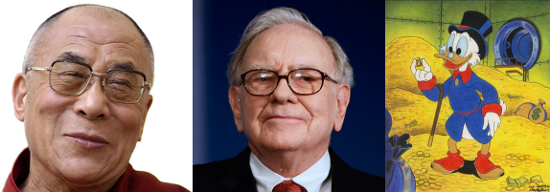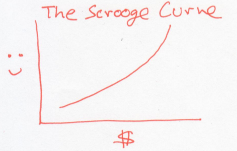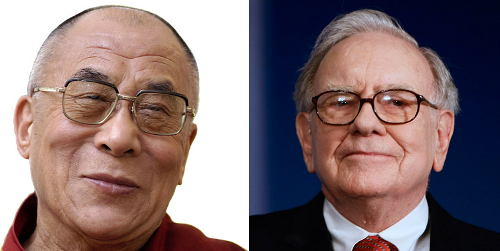What can the Dalai Lama teach us about absolute negative temperatures?
- Transfer
 A lot of noise has been heard recently in the scientific blogosphere about a recent experiment in which physicists created a gas from quantum particles with a negative temperature - below absolute zero . This is rather strange since it is assumed that absolute zero is such a temperature at which the movement of atoms stops when the moving particles in the usual state stop completely. Apparently, it is as cold as it can be. Could something be colder?
A lot of noise has been heard recently in the scientific blogosphere about a recent experiment in which physicists created a gas from quantum particles with a negative temperature - below absolute zero . This is rather strange since it is assumed that absolute zero is such a temperature at which the movement of atoms stops when the moving particles in the usual state stop completely. Apparently, it is as cold as it can be. Could something be colder? Here is a short answer. You can create negative temperatures . In fact, this was done for the first time.in 1951. But this is not how it actually sounds - these temperatures are not colder than absolute zero. For example, you cannot chill anything until the temperature drops below absolute zero. In fact, as I try to explain, objects with a negative temperature behave as if they are warmer than objects with any positive temperature.
To understand this, we first need to find out what physicists mean by temperature. You may remember from a school course in physics or chemistry that temperature measures the average kinetic energy of particle motion. When you heat a substance, you accelerate its molecules, and when it cools, slow them down.
This definition really makes sense if we can “touch” it with our own hands, thereforehere is a simulator where you can play with gas molecules. Turn on the Heater, then increase or decrease the Heater temperature and see what happens.
So far, so good. But physicists realized that this definition of temperature does not always work, because there are several types of energy besides the kinetic energy of motion. There are situations when an object has energy, but in the usual sense, no movement occurs, like magnetic spins in a magnet, or units and zeros on your hard drive. There are quantum systems where it makes no sense to talk about motion at all, but you can nonetheless find out how much energy the system has. It became clear that physicists needed more fundamental definitions of temperature in order to make room for these possibilities.
Here is a new definition that they came up with. Temperature measures the ability of an object to give energy . In truth, I lied. This is not how they actually determined the temperature, because physicists speak the language of mathematics, and not
 which means that the temperature is inversely proportional to the slope of the entropy curve compared to energy.
which means that the temperature is inversely proportional to the slope of the entropy curve compared to energy. Now, if you don’t speak “math,” I’m going to tell you one little secret. You do not need to know math or physics to understand how temperature works. You can use a surprisingly accurate analogy. I first heard it as a student in an excellent textbook on thermal physicsDaniel Schroeder.

Imagine a world where people continuously exchange money to achieve happiness. This is probably not something that is hard for you to imagine. But there is a slight twist.
People in this society have agreed that they will work to increase happiness - not just their own, but the general happiness of society. This has unexpected consequences. For example, there may be people who become very happy when they manage to earn some money. We could call them greedy . Other people do not care about money - they become a little happier when they make some money, and a little sadder when they lose it. These people are generous - playing by the rules of the game, they are obliged to give money to greedy people in order to raise the general happiness of society.
So why did I invent this socialist utopia with such rampant redistribution of income? This is because it is a close analogue to the physics of heat. As Stephen Colbert said : "Reality, as you know, has a liberal bias."
Here is an analogy. A socialist commune is what physicists call an isolated system. The people are the objects of this system. The money they exchange is energy, the total amount of which is always saved. Happiness is entropy. Just as society wants to maximize happiness, physical systems act to maximize their total entropy . And finally, generosity is the temperature - the willingness of people (objects) to give money (energy).
It’s hard to catch right away, so here’s a handy dictionary that allows you to translate our analogies into real physics:
money = energy
happiness = entropy
generosity = temperature
Looking at this dictionary, everything that we say about our commune translates into physical statements.
Now imagine that our society is made up of people like Warren Buffett. At first, when they are poor, receiving money makes them very happy. But, becoming richer the same amount of money, does not bring them as much happiness. If you build a graph of the happiness of these Buffett-like people in relation to their wealth, it will look something like this:

In this world, every dollar brings you less happiness than it received before. Thus, in order to increase global happiness, rich Buffetts must give money to poor Buffetts. This is a world where people become more generous as they receive money. Or a system whose temperature rises when it receives energy .
The Buffett curve describes the normal particles that we know and love, whose temperature rises when you warm them. These are moving atoms in solids, liquids or gases.
Now consider the world of people who hid, like Uncle Scrooge. Every dollar they earn makes them happier than the previous dollar.

Unlike the Buffetts, if wealthy Scrooges give money to poor Scrooges, this will reduce the overall happiness of the Scrooges. In other words, their generosity decreases as they acquire more money . Using our dictionary, this is a system in which temperature drops when it receives energy .
Cheer up this thought for a moment. Can you have an object that gets colder when you give it energy?
This really happens when you have bodies that are attracted to each other. Stars are held together by gravity and behave this way . When a star loses energy, its temperature rises. Give the star energy, and you will actually cool it. Black holes behave in the same strange way - the more energy you feed them, the more and colder they become.
And if that is not intuitive enough for you, here is another scenario. Imagine a world of people who have achieved enlightenment - they become happier when they lose money.

In this example, every dollar the Dalai Lama receives makes him sadder. A natural tendency, in this case, is to give all your money to someone who is ready to accept it. This strangely inverted curve is exactly the situation that results from negative temperatures - just redistribute happiness into entropy and money into energy (mathematically, the curve has a negative slope, so it should have negative temperatures).
What happens when objects with negative and positive temperatures meet? To find out, imagine the Dalai Lama met Warren Buffett.

Paradoxically, the Dalai Lama will give the money to the billionaire, because losing money makes the Dalai Lama happy, and getting the money will make Warren Buffett a little happier too. In this strange exchange, universal happiness is growing. Using our dictionary, energy transfers from objects with a negative temperature to objects with any positive temperature!
It may sound like something fictitious, by some too zealous theorist. But there are real substances where the entropy curve in relation to energy looks like the Dalai Lama's curve of happiness in relation to money, i.e. substances with absolute negative temperature.
To get such a substance, you need to design a system that has an upper energy limit. This is a very rare thing - the normal, everyday things that we interact with have kinetic energy of motion, and there is no upper limit on how much kinetic energy a substance can have.
Systems with an upper energy limit do not want to be in a high energy state. Just as the Dalai Lama does not like a lot of money, these systems have low entropy, i.e. low probability of being in a high energy state. You must experimentally “trick” the system to get such a substance.
This was first done in a brilliant experiment by Purcell and Poundin 1951, where they managed to fool the spins of nuclei in a lithium fluoride crystal. In this experiment, they maintained an absolute negative temperature for several minutes. Since then, negative temperatures have been obtained in many experiments, and most recently recreated in a completely different sphere - ultracold quantum gas atoms were obtained in a laser trap .
From black holes to quantum gas, this analogy shows us that temperature is something more subtle than what we measure with a thermometer.
